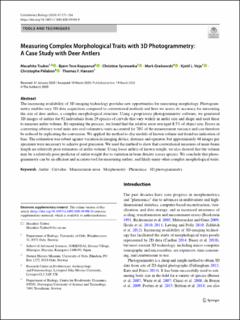| dc.contributor.author | Tsuboi, Masahito | |
| dc.contributor.author | Kopperud, Bjørn Tore | |
| dc.contributor.author | Mayer, Christine | |
| dc.contributor.author | Grabowski, Mark Walter | |
| dc.contributor.author | Voje, Kjetil L. | |
| dc.contributor.author | Pelabon, Christophe | |
| dc.contributor.author | Hansen, Thomas F | |
| dc.date.accessioned | 2021-02-17T13:34:27Z | |
| dc.date.available | 2021-02-17T13:34:27Z | |
| dc.date.created | 2021-01-01T18:58:39Z | |
| dc.date.issued | 2020 | |
| dc.identifier.citation | Evolutionary biology. 2020, 47 175-186. | en_US |
| dc.identifier.issn | 0071-3260 | |
| dc.identifier.uri | https://hdl.handle.net/11250/2728708 | |
| dc.description.abstract | The increasing availability of 3D-imaging technology provides new opportunities for measuring morphology. Photogrammetry enables easy 3D-data acquisition compared to conventional methods and here we assess its accuracy for measuring the size of deer antlers, a complex morphological structure. Using a proprietary photogrammetry software, we generated 3D images of antlers for 92 individuals from 29 species of cervids that vary widely in antler size and shape and used these to measure antler volume. By repeating the process, we found that the relative error averaged 8.5% of object size. Errors in converting arbitrary voxel units into real volumetric units accounted for 70% of the measurement variance and can therefore be reduced by replicating the conversion. We applied the method to clay models of known volume and found no indication of bias. The estimation was robust against variation in imaging device, distance and operator, but approximately 40 images per specimen were necessary to achieve good precision. We used the method to show that conventional measures of main-beam length are relatively poor estimators of antler volume. Using loose antlers of known weight, we also showed that the volume may be a relatively poor predictor of antler weight due to variation in bone density across species. We conclude that photogrammetry can be an efficient and accurate tool for measuring antlers, and likely many other complex morphological traits. | en_US |
| dc.language.iso | eng | en_US |
| dc.publisher | Springer | en_US |
| dc.rights | Navngivelse 4.0 Internasjonal | * |
| dc.rights.uri | http://creativecommons.org/licenses/by/4.0/deed.no | * |
| dc.title | Measuring Complex Morphological Traits with 3D Photogrammetry: A Case Study with Deer Antlers | en_US |
| dc.type | Peer reviewed | en_US |
| dc.type | Journal article | en_US |
| dc.description.version | publishedVersion | en_US |
| dc.source.pagenumber | 175-186 | en_US |
| dc.source.volume | 47 | en_US |
| dc.source.journal | Evolutionary biology | en_US |
| dc.identifier.doi | 10.1007/s11692-020-09496-9 | |
| dc.identifier.cristin | 1864266 | |
| dc.relation.project | Norges forskningsråd: 223257 | en_US |
| dc.relation.project | Norges forskningsråd: 258580 | en_US |
| dc.description.localcode | Open Access This article is licensed under a Creative Commons Attribution 4.0 International License, which permits use, sharing, adaptation, distribution and reproduction in any medium or format, as long as you give appropriate credit to the original author(s) and the source, provide a link to the Creative Commons licence, and indicate if changes were made. The images or other third party material in this article are included in the article's Creative Commons licence, unless indicated otherwise in a credit line to the material. If material is not included in the article's Creative Commons licence and your intended use is not permitted by statutory regulation or exceeds the permitted use, you will need to obtain permission directly from the copyright holder. To view a copy of this licence, visit http://creativecommons.org/licenses/by/4.0/. | en_US |
| cristin.ispublished | true | |
| cristin.fulltext | original | |
| cristin.qualitycode | 1 | |

